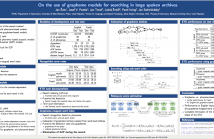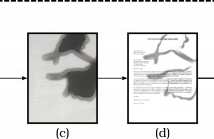
ICASSP is the world’s largest and most comprehensive technical conference focused on signal processing and its applications. The 2019 conference will feature world-class presentations by internationally renowned speakers, cutting-edge session topics and provide a fantastic opportunity to network with like-minded professionals from around the world. Visit website.

The mutual interference between similar radar systems can result in reduced radar sensitivity and increased false alarm rates.
To address the interference mitigation problems in similar radar systems, we propose herein two slow-time coding schemes to modulate the pulses within a coherent processing interval (CPI).
The incorporation of the coding schemes only requires slight modification of the existing systems.
- Categories:
 37 Views
37 Views
- Read more about Bayesian anisotropic Gaussian model for audio source separation
- Log in to post comments
In audio source separation applications, it is common to model the sources as circular-symmetric Gaussian random variables, which is equivalent to assuming that the phase of each source is uniformly distributed. In this paper, we introduce an anisotropic Gaussian source model in which both the magnitude and phase parameters are modeled as random variables. In such a model, it becomes possible to promote a phase value that originates from a signal model and to adjust the relative importance of this underlying model-based phase constraint.
- Categories:
 14 Views
14 Views
- Read more about Diabetic Retinopathy Detection Based on Deep Convolutional Neural Networks
- Log in to post comments
- Categories:
 44 Views
44 Views
- Read more about High-speed light field image formation analysis using wavefield modeling with flexible sampling
- Log in to post comments
In order to understand the image formation inside plenoptic systems, a wave-optic-based model is proposed in this paper that uses the Fresnel diffraction equation to propagate the whole object field into the plenoptic systems. The proposed model is much flexible at sampling on propagation planes by utilizing the method of multiple partial propagations. In order to verify the effectiveness of the proposed model, numerical simulations are conducted by comparing with existing wave optic model under different optical configurations of plenoptic cameras.
- Categories:
 6 Views
6 Views
- Read more about High-speed light field image formation analysis using wavefield modeling with flexible sampling
- Log in to post comments
In order to understand the image formation inside plenoptic systems, a wave-optic-based model is proposed in this paper that uses the Fresnel diffraction equation to propagate the whole object field into the plenoptic systems. The proposed model is much flexible at sampling on propagation planes by utilizing the method of multiple partial propagations. In order to verify the effectiveness of the proposed model, numerical simulations are conducted by comparing with existing wave optic model under different optical configurations of plenoptic cameras.
- Categories:
 9 Views
9 Views
- Read more about TV-SVM: Support Vector Machine with Total Variational Regularization
- Log in to post comments
To leverage the spatial relationship of lattice data, such as images, we introduce total variational (TV) regularization into support vector machines (SVM), called TV-SVM. TV-SVM encourages local smoothness and sparsity in gradient domain of the learned parameters. TV-SVM is optimized via the alternating direction method of multipliers (ADMM) algorithm and is significantly better than (Linear) SVM for image classifications.
- Categories:
 50 Views
50 Views
- Read more about On the use of grapheme models for searching in large spoken archives
- Log in to post comments
This paper explores the possibility to use grapheme-based word and sub-word models in the task of spoken term detection (STD). The usage of grapheme models eliminates the need for expert-prepared pronunciation lexicons (which are often far from complete) and/or trainable grapheme-to-phoneme (G2P) algorithms that are frequently rather inaccurate, especially for rare words (words coming from a~different language). Moreover, the G2P conversion of the search terms that need to be performed on-line can substantially increase the response time of the STD system.
poster.pdf
- Categories:
 76 Views
76 Views
Uneven illumination and shadows in document images cause a challenge for digitization applications and automated workflows. In this work, we propose a new method to recover un-shadowed document images from images with shadows/uneven illumination. We pose this problem as one of estimating the shading and reflectance components of the given original image. Our method first estimates the shading and uses it to compute the reflectance. The output reflectance map is then used to improve the shading and the process is repeated in an iterative manner.
- Categories:
 111 Views
111 Views- Read more about IMAGE REPRESENTATION USING SUPERVISED AND UNSUPERVISED LEARNING METHODS ON COMPLEX DOMAIN
- Log in to post comments
Matrix factorization (MF) and its extensions have been intensively studied in computer vision and machine learning. In this paper, unsupervised and supervised learning methods based on MF technique on complex domain are introduced. Projective complex matrix factorization (PCMF) and discriminant projective complex matrix factorization (DPCMF) present two frameworks of projecting complex data to a lower dimension space. The optimization problems are formulated as the minimization of the real-valued functions of complex variables.
- Categories:
 8 Views
8 Views- Read more about IMAGE REPRESENTATION USING SUPERVISED AND UNSUPERVISED LEARNING METHODS ON COMPLEX DOMAIN
- Log in to post comments
Matrix factorization (MF) and its extensions have been intensively studied in computer vision and machine learning. In this paper, unsupervised and supervised learning methods based on MF technique on complex domain are introduced. Projective complex matrix factorization (PCMF) and discriminant projective complex matrix factorization (DPCMF) present two frameworks of projecting complex data to a lower dimension space. The optimization problems are formulated as the minimization of the real-valued functions of complex variables.
- Categories:
 2 Views
2 Views